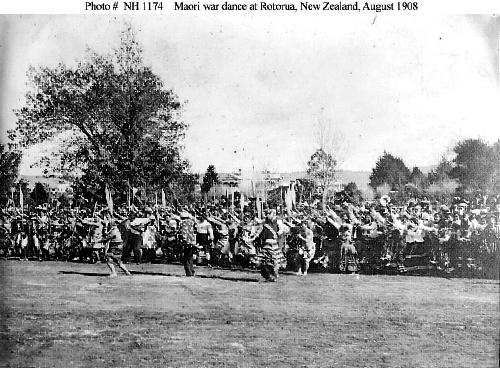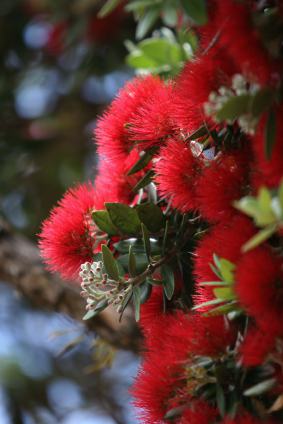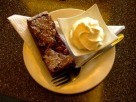- Home
- Māori Culture
- Māori Haka
Māori Haka
If you haven't seen a Māori haka before or a Māori warrior, make sure it's on your list of things to do when you visit Rotorua. Executed well, a haka literally makes the hairs stand up on the back of the neck.
 Te Arawa Welcome The Great White Fleet 1908 With A Haka - Collection of Lieutenant Commander Richard Wainwright, 1928. US Naval History and Heritage Command Photograph
Te Arawa Welcome The Great White Fleet 1908 With A Haka - Collection of Lieutenant Commander Richard Wainwright, 1928. US Naval History and Heritage Command PhotographWhat Is The Māori Haka?
The Māori haka is essentially a group dance involving aggressive looking movements accompanied by chanted words. It is a dance that incorporates the whole body.
With the movements the feet stamp, hands slap thighs and chests, fists clench tightly, eyes are wide open rolling back into the head or from side to side, the tongue protrudes as far as it will go, the chords in the neck strain to seemingly breaking point.
Join all that to voices that harmonise, yell and chant and it sometimes gets really quite eerie.
I
am only sorry that these words can't begin to convey, even a little
bit, the passion and emotion that is present in a great haka. I have
looked at videos on UTube and they are the same, not a patch on the real
thing. One thing is for sure and that is, you will not be left
untouched if you see it in the flesh.
When Is A Haka Used?
Wiri Gardiner, in his book, HAKA - A Living Tradition, is eloquent when he says that, "It provides a powerful and dramatic vehicle for welcoming visitors, for challenging opponents, for rejoicing in victories, for protesting injustices, and for celebrating culture and a way of life."
From that description alone you can see that this dance is an integral part of the Māori culture used for all sorts of occasions.
If you attend any activity that will involve a Māori haka, your group will be challenged on arrival. There is then a response by your group - back and forth - until you come together with a hongi (pressing noses together as a greeting). You don't have to worry about responding yourself as somebody will be present to represent you.
Different Types of Haka
There are or were many types, but over time they have evolved as all things do resulting in a loss of parts of the old ways. The literature available makes it hard to pin down one specific description for the different types of haka because of the varying opinions.
There were different haka for war with the commonality being that they were performed with weapons.
Haka Peruperu: The Haka Peruperu was referred to as the true Māori war dance by Lieutenant-Colonel Arapeta Awatere. He led the 28th (Māori) Battalion in the second world war and was a renowned expert in this field.
In this one the warriors jump up high with the legs tucked under.
Also included amongst the Māori war dances is Haka Puha and Tūtūngārahu which then have their own variations depending on the tribe.
One
of the earlier observers described how the war party going into battle
would have to gather on the marae and perform a Māori war dance. But, it
was actually an inspection. If the members were not synchronised in
their jumps it foretold of upcoming disaster. Talk about pressure. They
got to repeat it though to "gain better omens."
Haka Taparahi: Was performed without weapons and is what is usually seen in today's world. It uses postures and shouting.
Other Haka:
The grouping of the above two types of dances has been disputed by M.
McLean and M. Orbell, authors of Traditional Songs of the Māori. In
their descriptions the haka are categorised by function, manner of
performance, grouping of performers, funeral compositions and other
types. Nineteen of them.
You can see from this that a lot of confusion can arise.
If you are interested in learning in-depth about this subject there are some great authors out there. Wira Gardiner and Tīmoti Kāretu both have really good books on the subject. They have delved into the origins and history of the haka utilising, amongst other things, written observations from earlier visitors to our shores, their own knowledge and also the knowledge of elders who had the expertise.
|
Sources: |
|
If you are interested in looking further into either of these books, type your query into Fishpond's searchbox below. Fishpond is a company that I use frequently to purchase books online and I have never had a problem with them.
You May Also Like...
Souvenir Shops - Find the perfect mementos
Rotorua Museum - Learn more about the culture
1 Day in Rotorua - Tours that don't waste time
Rotorua Blog - Features our latest pages
- Home
- Māori Culture
- Māori Haka






